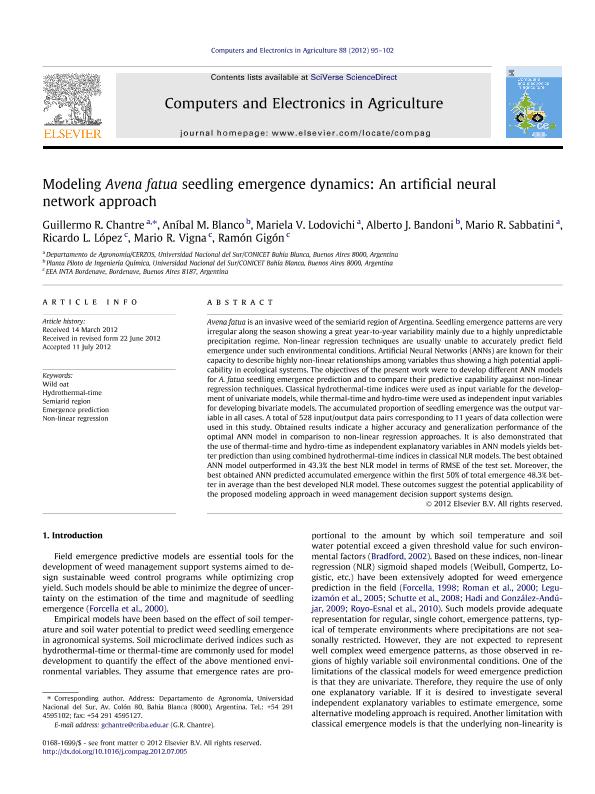Mostrar el registro sencillo del ítem
dc.contributor.author
Chantre Balacca, Guillermo Ruben

dc.contributor.author
Blanco, Anibal Manuel

dc.contributor.author
Lodovichi, Mariela Victoria

dc.contributor.author
Bandoni, Jose Alberto

dc.contributor.author
Sabattini, Rafael Alberto

dc.contributor.author
López, Ricardo L.
dc.contributor.author
Vigna, Mario Raul

dc.contributor.author
Gigón, Ramón

dc.date.available
2018-08-01T17:50:42Z
dc.date.issued
2012-08-11
dc.identifier.citation
Chantre Balacca, Guillermo Ruben; Blanco, Anibal Manuel; Lodovichi, Mariela Victoria; Bandoni, Jose Alberto; Sabattini, Rafael Alberto; et al.; Modeling Avena fatua seedling emergence dynamics: An artificial neural network approach; Elsevier; Computers and Eletronics in Agriculture; 88; 11-8-2012; 95-102
dc.identifier.issn
0168-1699
dc.identifier.uri
http://hdl.handle.net/11336/53770
dc.description.abstract
Avena fatua is an invasive weed of the semiarid region of Argentina. Seedling emergence patterns are very irregular along the season showing a great year-to-year variability mainly due to a highly unpredictable precipitation regime. Non-linear regression techniques are usually unable to accurately predict field emergence under such environmental conditions. Artificial Neural Networks (ANNs) are known for their capacity to describe highly non-linear relationships among variables thus showing a high potential applicability in ecological systems. The objectives of the present work were to develop different ANN models for A. fatua seedling emergence prediction and to compare their predictive capability against non-linear regression techniques. Classical hydrothermal-time indices were used as input variable for the development of univariate models, while thermal-time and hydro-time were used as independent input variables for developing bivariate models. The accumulated proportion of seedling emergence was the output variable in all cases. A total of 528 input/output data pairs corresponding to 11 years of data collection were used in this study. Obtained results indicate a higher accuracy and generalization performance of the optimal ANN model in comparison to non-linear regression approaches. It is also demonstrated that the use of thermal-time and hydro-time as independent explanatory variables in ANN models yields better prediction than using combined hydrothermal-time indices in classical NLR models. The best obtained ANN model outperformed in 43.3% the best NLR model in terms of RMSE of the test set. Moreover, the best obtained ANN predicted accumulated emergence within the first 50% of total emergence 48.3% better in average than the best developed NLR model. These outcomes suggest the potential applicability of the proposed modeling approach in weed management decision support systems design.
dc.format
application/pdf
dc.language.iso
eng
dc.publisher
Elsevier

dc.rights
info:eu-repo/semantics/openAccess
dc.rights.uri
https://creativecommons.org/licenses/by-nc-nd/2.5/ar/
dc.subject
Wild Oat
dc.subject
Hydorthermal Time
dc.subject
Semiarid Region
dc.subject
Emergence Prediction
dc.subject.classification
Otras Ingeniería Química

dc.subject.classification
Ingeniería Química

dc.subject.classification
INGENIERÍAS Y TECNOLOGÍAS

dc.title
Modeling Avena fatua seedling emergence dynamics: An artificial neural network approach
dc.type
info:eu-repo/semantics/article
dc.type
info:ar-repo/semantics/artículo
dc.type
info:eu-repo/semantics/publishedVersion
dc.date.updated
2018-07-11T13:46:17Z
dc.journal.volume
88
dc.journal.pagination
95-102
dc.journal.pais
Países Bajos

dc.journal.ciudad
Amsterdam
dc.description.fil
Fil: Chantre Balacca, Guillermo Ruben. Universidad Nacional del Sur; Argentina. Consejo Nacional de Investigaciones Científicas y Técnicas. Centro Científico Tecnológico Conicet - Bahía Blanca; Argentina
dc.description.fil
Fil: Blanco, Anibal Manuel. Consejo Nacional de Investigaciones Científicas y Técnicas. Centro Científico Tecnológico Conicet - Bahía Blanca. Planta Piloto de Ingeniería Química. Universidad Nacional del Sur. Planta Piloto de Ingeniería Química; Argentina
dc.description.fil
Fil: Lodovichi, Mariela Victoria. Consejo Nacional de Investigaciones Científicas y Técnicas. Centro Científico Tecnológico Conicet - Bahía Blanca; Argentina. Universidad Nacional del Sur; Argentina
dc.description.fil
Fil: Bandoni, Jose Alberto. Consejo Nacional de Investigaciones Científicas y Técnicas. Centro Científico Tecnológico Conicet - Bahía Blanca. Planta Piloto de Ingeniería Química. Universidad Nacional del Sur. Planta Piloto de Ingeniería Química; Argentina
dc.description.fil
Fil: Sabattini, Rafael Alberto. Universidad Nacional del Sur; Argentina. Consejo Nacional de Investigaciones Científicas y Técnicas. Centro Científico Tecnológico Conicet - Bahía Blanca; Argentina
dc.description.fil
Fil: López, Ricardo L.. Instituto Nacional de Tecnología Agropecuaria. Centro Regional Buenos Aires Sur. Estación Experimental Agropecuaria Bordenave; Argentina
dc.description.fil
Fil: Vigna, Mario Raul. Instituto Nacional de Tecnología Agropecuaria. Centro Regional Buenos Aires Sur. Estación Experimental Agropecuaria Bordenave; Argentina
dc.description.fil
Fil: Gigón, Ramón. Instituto Nacional de Tecnología Agropecuaria. Centro Regional Buenos Aires Sur. Estación Experimental Agropecuaria Bordenave; Argentina
dc.journal.title
Computers and Eletronics in Agriculture

dc.relation.alternativeid
info:eu-repo/semantics/altIdentifier/doi/http://dx.doi.org/10.1016/j.compag.2012.07.005
dc.relation.alternativeid
info:eu-repo/semantics/altIdentifier/url/https://www.sciencedirect.com/science/article/pii/S0168169912001901
Archivos asociados
